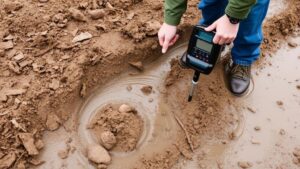Strategies for Metal Detecting in Recently Exposed Earth Layers
Strategies for Metal Detecting in Recently Exposed Earth Layers
Metal detecting is a rewarding hobby that combines history, adventure, and technology. Recently exposed earth layers present unique opportunities for metal detecting enthusiasts. This article delves into effective strategies for maximizing findings in these freshly disturbed environments.
Understanding Earth Layers and Recent Disturbances
To improve metal detecting success, it is essential to comprehend the layers of soil and their characteristics. earths stratification includes:
- Topsoil: The uppermost layer rich in organic material.
- Subsoil: Beneath topsoil, usually denser with minerals.
- Parent Material: The layer from which the soil is derived, often consisting of rock or weathered material.
Recent disturbances, such as construction, agriculture, or natural erosion, can expose older layers that may contain artifacts. This exposure creates a unique opportunity to discover valuable items that were previously buried. Understanding the age and composition of these layers can aid in predicting the likelihood of finds.
Choosing the Right Equipment
The choice of metal detector greatly influences the efficiency of searches in exposed earth layers. Key features to consider include:
- Frequency Range: Higher frequencies are better for detecting smaller items, while lower frequencies penetrate deeper.
- Search Modes: Detectors with multiple modes (e.g., all-metal, discrimination) allow for customization based on the environment.
- Ground Balance: Automatic or manual ground balancing helps mitigate the effects of mineralization.
For example, the Minelab Equinox 800 is popular for its adjustable frequency settings and excellent discrimination capabilities, making it suitable for various soil types.
Site Selection and Research
Scouting the right locations is crucial for successful metal detecting. Factors to consider include:
- Historical Context: Sites with known historical significance, such as battlefields or old homesteads, can yield valuable finds.
- Current Conditions: Areas that have recently been disturbed, such as construction sites or landslide-prone areas, often reveal buried treasures.
Case studies show that many significant finds occur at sites with both historical relevance and recent disturbance. For example, metal detecting at the site of a former gold rush town in California revealed numerous artifacts after a recent erosion event, including tools and coins from the era.
Timing Your Searches
The timing of metal detecting adventures can significantly influence success rates. Optimal conditions include:
- Post-Rainfall: Rain can wash away surface soil and enhance metal detection signal clarity.
- After Construction: Newly disturbed soil often presents artifacts that were not previously accessible.
Many seasoned detectorists recommend conducting searches shortly after heavy rains or site clearing, as these conditions can expose previously hidden treasures.
Techniques for Effective Searching
Brushing up on effective searching techniques is vital for maximizing finds in recently exposed layers. Employ the following strategies:
- Grid Pattern Searching: Methodically searching in grid patterns ensures thorough coverage of an area.
- Slow Sweeping: Slow and steady sweeping allows for better detection of faint signals.
- Layer Discrimination: Different layers may contain unique materials, allowing for methodical discrimination to target specific depths.
For example, utilizing a grid search at a site where construction work has disturbed the ground can help identify the boundaries of potential treasure areas, increasing the likelihood of recovering valuable items.
Legal and Ethical Considerations
It is critical to understand legal regulations regarding metal detecting in your area. Important actions include:
- Permits: Always check if permits are necessary for detecting on public or restricted lands.
- Respect Private Property: Obtain permission before searching on private lands.
Following legal guidelines not only ensures you remain compliant but also fosters goodwill within the local community. Many detectorists have established positive relationships with landowners by respecting property rights and sharing their findings.
Conclusion
Employing effective strategies for metal detecting in recently exposed earth layers can lead to exciting discoveries. By understanding earth layers, selecting the right equipment, choosing optimal sites, timing searches wisely, employing proven techniques, and adhering to legal considerations, enthusiasts can enhance their metal detecting experiences. As you venture into your metal detecting endeavors, remember to conduct thorough research, remain patient, and respect historical findings, helping preserve the past as you unearth treasures.


